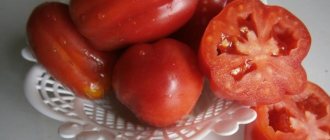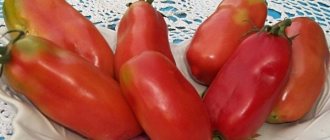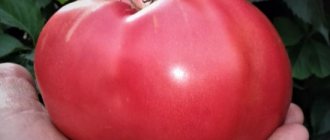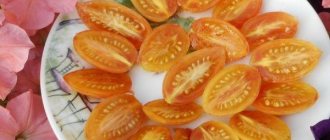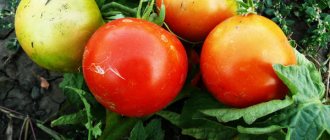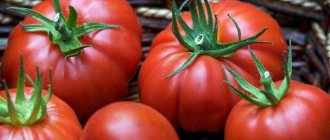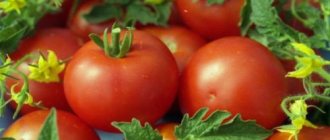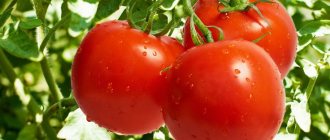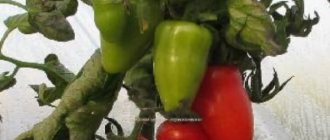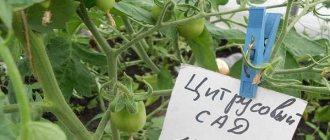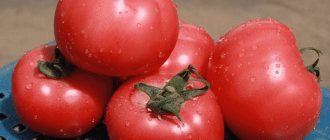An absolute delight, the Qingdao tomato, which any gardener can grow, is the epitome of productivity and wonderful taste. Large tomatoes are ideal for salads and summer cuts. You can prepare a variety of healthy dishes from them and make a lot of preparations.
| Height | Landing location | Ripening time | Fruit color | Fruit size | Origin | Fruit shape |
| Medium height | Greenhouse, Open ground | Mid-season | Reds | Large | Variety | Flat-round |
Basic ideas about the variety
To get the declared yield, you need to grow tomatoes correctly. The description of the variety contains all the necessary information; it will help you correctly position the plant on the site and properly care for it.
Plant:
- Bush: indeterminate.
- Height: 1.2–1.3 m.
- Number of tomatoes in a brush: 7–9 pcs.
- Ripening time: 110–120 days.
Fruit:
- Shape: flat-round.
- Weight: 200–400 g.
- Color: dark brown.
- Density: high.
- Number of cameras: many.
- Taste: sweet.
- Transportability: poor.
- Shelf life: several days.
Description of the variety
The Qingdao plant is a medium-sized bush of an indeterminate species. Thus, their maximum height is only 130 cm. From 7 to 10 tomatoes can grow on one brush. This variety is a medium-ripening variety, and the first fruits after planting can be obtained after 115 days.
Qingdao fruits are oval in shape. The average weight is about 300 grams. Color – brown, darkish. The pulp is quite fleshy and dense. The fruits have a lot of chambers from which seed material can be extracted.
The taste characteristics of Qingdao are at a high level. The fruits are mostly sweet. Among the disadvantages, one can highlight the poor transportability of the variety, due to its low shelf life. This variety also has a very short shelf life - only a couple of days after harvest.
Planting and caring for plants
Growing tomatoes is a simple process; the main thing is to follow all the necessary agricultural practices. Seeds for seedlings are sown 2 months before planting in the ground. Planting dates are calculated individually, taking into account the characteristics of the growing region.
To increase the productivity of the bush, you can remove the growing point. Then the fruits will be larger.
At the stage of appearance of 2 true leaves, tomatoes dive. Be sure to carry out hardening. Getting used to sunlight makes plants less susceptible to stress when transplanted to a permanent location. It is recommended to plant 3 plants per 1 m2. Shaping and tying to supports is required. Summer residents recommend forming 2–3 stems.
Tomatoes are watered most often in the evening. It is advisable that the water be warm. You can feed with complex fertilizers. At least 2 times when they bloom and actively ripen.
How to plant and care
Important
! In order for each Qingdao bush to bear as many fruits as possible, its “growth point” must be removed. Moreover, in this case the fruits will grow as large as possible.
After planting the seedlings, when 3 more or less large leaf plates appear, the plant must be pruned. It is also necessary to harden off before transplanting to open areas. Gradually getting used to the sun's rays, Qingdao bushes become more stress-resistant to transplanting into the garden.
Qingdao planting scheme - no more than 3 bushes per square meter. m. area. Also, the bushes need to be systematically tied up and the stems formed. The optimal number of the latter is 3-4 stems.
Watering tomatoes should be done in the evening, after 18:00. The water should be slightly warmed up. It is worth fertilizing the bushes with complex preparations - at least twice per season.
Harvest volume and application
Productivity is an important criterion for choosing a variety. “Tsingtao” tomatoes can produce about 10 kg per plant. Thus, 1 m2 will give 25–30 kg.
See also
Description of tomato variety Ivan Kupala and its characteristicsRead
They are mainly used only for processing, since they are not suitable for preservation whole. Perfect for juices, ketchups and other tomato derivatives. From the reviews of summer residents it is clear that the taste of tomatoes does not change, regardless of where they ripen at home or on the bush.
Tomato Qingdao
photo author Evgeny Balashov
Description and characteristics of the Qingdao tomato variety, reviews, photos
Indeterminate, mid-season, medium-growing, productive tomato variety. In the middle zone, it is recommended to grow it in a greenhouse.
The bush is 1.2-1.3 meters high; it requires tying to a support and pinching. The best results were obtained when forming a plant with 2 or 3 stems.
Basic qualities of fruits
photo author Elena Frolova
The fruits are flat-round, dark brown in color at maturity (often with dark green shoulders), weighing 300-400 grams, very sweet, juicy, and tasty. One of the best dark-fruited varieties. These tomatoes are suitable for fresh consumption, making juices and sauces.
The downside of this variety is that the fruits are not long-lasting at all; you need to immediately find a use for them. It ripens quickly on the bush; you need to “watch” the harvest time.
Features of cultivation
We recommend sowing the seeds of this tomato variety for seedlings 60-65 days before the intended planting in the ground. When planting seedlings in a permanent place per 1 sq. Place no more than 3 plants per meter of plot.
photo author Evgeny Balashov
If you grew Qingdao tomatoes, please write whether you liked them or not. What was the yield and taste of the fruit? When did you pick your first tomato? Briefly describe the advantages and disadvantages of this tomato in your opinion. If possible, attach a photo of these tomatoes to your comment. Thank you!
Your reviews of the Qingdao tomato and additions to the description will help many gardeners objectively evaluate this variety and decide whether it is worth growing or not.
Positive and negative aspects of the variety
Dividing the properties of a tomato into positive and negative helps the gardener make the final choice in favor of the species.
Pros:
- Productivity.
- Unpretentiousness.
- Friendly maturation.
- The fruits do not crack.
- Great taste.
Minuses:
- Mandatory formation.
- Fruits cannot be stored or transported.
- Treatment is required to prevent disease.
The best medium-sized varieties of tomatoes
Choosing a good variety of tomatoes can be quite difficult, because they all differ in the agrotechnical characteristics of cultivation and the taste characteristics of the fruit. Thus, some farmers prefer to grow tall tomatoes, which require careful care, gartering and bush formation. However, in gratitude for the care, “green giants” over 2 meters high are able to please the gardener with record yields. The antipode of tall tomatoes are standard tomatoes, the height of which does not exceed 60 cm. Such varieties of tomatoes do not require much attention, however, their yield is low. At the same time, most gardeners choose the “golden mean”, growing medium-sized varieties of tomatoes. They combine ease of care and high yield. A description of the main characteristics and photos of the most popular medium-sized tomatoes is given below in the article.
The best medium-sized tomatoes
It is customary to call varieties of tomatoes whose bush height does not exceed 1.5 meters as medium-sized. There are quite a lot of varieties that fall under this parameter, but among them there are the most popular ones, which are popular among beginners and experienced farmers. Thus, we can distinguish a number of medium-sized tomato varieties that are well adapted to domestic climatic conditions, are undemanding in care, have high yields and excellent fruit taste.
Satin
If you decide to grow a variety with large, tasty tomatoes in your garden, you should pay attention to the “Satin” tomato. These tomatoes have an amazing taste and aroma. Their flesh is juicy, dense, ideally combining sweetness and light sourness. The fruits can be used not only for preparing summer vegetable salads, but also for winter preparations. You can also make very tasty tomato paste or juice from the “Atlas” variety of tomatoes.
The external description of the fruit can perhaps be called ideal: each tomato weighs from 150 to 300 grams, its surface is glossy, bright red, and the shape is classic for the crop - flat-round. Such large fruits ripen in 100-105 days, from the day the seed is sown.
Growing Satin tomatoes is not at all difficult. To do this, in mid-May it is necessary to sow seeds for seedlings and plant young plants in open ground or under film cover in early June. The layout of plants on ridges should include no more than 6-7 bushes per 1 m2 of soil. Basic care for tomatoes consists of watering, weeding and loosening. It is recommended to periodically feed the bushes with mineral fertilizers.
Tomatoes of the “Atlasny” variety are medium-sized, their height is approximately 60-70 cm. The bush is medium-leaved, but quite powerful, so during the growing season, if necessary, excess shoots should be removed. Under favorable conditions and proper care, mass ripening of fruits occurs in late July - early August. A special feature of the variety is the uniform ripening of tomatoes. The yield of vegetables is high and can reach 11 kg/m2.
Krone F1
A stunning mid-early tomato variety. It has a number of advantages, thanks to which it is loved by gardeners in Moldova, Ukraine, and Russia. Its main advantage, compared to other varieties, is the very short period of fruit ripening. So, from the day of sowing the seed to the onset of the active phase of fruiting, a little more than 85 days should pass. This allows you to obtain fresh vegetables in early spring in heated greenhouses for subsequent personal consumption and for sale. This also becomes possible thanks to the high yield of the “Krona” variety, which exceeds 12 kg/m2.
It is worth noting that Krona tomatoes can be grown in open ground, in greenhouses and greenhouses. The height of the plants is within 1-1.5 meters, which requires mandatory garter. Also, a medium-sized, semi-determinate bush requires abundant watering and fertilizing, which will make the harvest not only abundant, but also surprisingly tasty and ripen in a timely manner.
By looking at the photo above, you can visually evaluate the excellent external qualities of tomatoes. Each vegetable of the Krona variety weighs 100-150 grams. Tomatoes have a round, slightly flattened shape. Their pulp is tasty, aromatic, but slightly sour. At the same time, the skin is very thin and delicate. The purpose of delicious tomatoes is universal. They can be an ideal ingredient in a fresh vegetable salad or a delight in winter preparations.
Kyiv 139
“Kyiv 139” is another variety that allows you to get an ultra-early harvest of tasty tomatoes in a heated greenhouse. Thus, in protected conditions, the period of fruit ripening is only 90 days. However, when cultivating the variety in open areas of soil, ripe tomatoes will have to wait approximately 120 days. It is worth noting that tomatoes of the “Kyiv 139” variety can be cultivated by seedlings or by direct sowing of seeds in the ground.
The plant is determinate, medium-sized. The height of its bushes is just over 60 cm. For normal growth and timely fruiting, the crop needs watering and fertilizing with mineral fertilizers. The variety is resistant to diseases and does not require treatment with chemicals during the growing season.
The variety "Kyiv 139" is large-fruited. Each tomato weighs approximately 150 grams. The vegetables taste great. They are widely used in fresh and canned form. The tomato pulp is juicy and tender, containing a large amount of sugar and dry matter. At the same time, dense tomatoes are able to retain their shape even after heat treatment. The tomato peel is thin, but not prone to cracking. Vegetables are painted red. On their surface you can observe a characteristic greenish spot at the stalk, which persists even after the vegetables reach technical ripeness.
Long lasting
Storing fresh tomatoes for 5 months after harvest is quite possible if we are talking about tomatoes of the “Long-lasting” variety. These large vegetables have very dense flesh and elastic skin. They retain their shape well, are resistant to mechanical damage and are suitable for long-term transportation. Thanks to these qualities, the “Long-lasting” variety is often grown by professional farmers on an industrial scale for subsequent sale.
Medium-sized tomatoes of the “Long-lasting” variety are grown in open areas of land. In this case, the seedling cultivation method is used, followed by picking plants according to the scheme of 4-5 pcs. per 1 m 2. The height of tomatoes of this variety can reach 1 m, which means that the bushes must be tied to a trellis. Regular loosening, watering and fertilizing will allow the plant to develop correctly and bear fruit in full in a timely manner. There is no need to treat plants with chemicals during the growing season, since they have a high degree of protection against diseases at the genetic level.
The fruits of this unique variety are pink-pearl colored. Their shape is perfectly smooth and round. However, it is worth noting that the taste of tomato is sour, without much aroma or sweetness. The vegetable is great for canning and pickling. Also, do not forget about the possibility of long-term storage of fruits.
Precosix F1
When choosing a tomato variety for subsequent canning, you should pay attention to the Precosix f1 hybrid. Its fruits are very dense and practically do not contain seed chambers or free liquid. At the same time, the skin of tomatoes is quite tender and thin. The microelement composition of the vegetable contains a large amount of sugar and dry substances.
It is recommended to grow the Precosix f1 variety in open ground. Its bushes are determinate, heavily leafy, which requires pinching. In general, the crop is undemanding in care and can successfully withstand drought and short-term cold snaps. It is resistant to diseases such as nematode, fusarium, and verticillium.
Red tomatoes have a cuboid-oval shape. Their size is small, the average weight is approximately 60-80 grams. It is convenient to roll up such small tomatoes whole-fruited. Tomatoes take approximately 100-105 days to ripen. The total crop yield, depending on soil fertility and compliance with care rules, varies from 3 to 6 kg/m2.
White giant
The name of the variety “White Giant” largely speaks for itself. Its fruits are green when ripe and turn white when ripe. Their average weight is 300 g. The flat-round fruits are quite dense and tasty. Their flesh is juicy and tender. The microelement composition of the fruit includes a large amount of sugar, which makes the vegetable very tasty, which is why tomatoes are often used to prepare fresh salads. However, some housewives use such tomatoes for canning.
Bushes of the “White Giant” variety are medium-sized, powerful, heavily leafy. Their height is approximately 1 m. The crop is grown mainly in open areas of land. Plants are planted at 3-4 bushes per 1 m2.
The White Giant variety is excellent for early cultivation. The period from sowing the seed to the ripening of the fruits of this crop is only 80-90 days. This allows you to get a harvest in early June when cultivated in a greenhouse.
lady finger
Quite a noticeable variety of tomatoes, which is famous for its very tasty fruits of an unusual cylindrical shape. The mass of elongated, red fruits is small, approximately 140 g. At the same time, the taste of the vegetables is excellent: the flesh is fleshy, sweet, juicy. The skin of tomatoes is tender and thin. The purpose of tomatoes is universal. They are widely used for canning, preparing fresh dishes and tomato paste and juice.
The crop is thermophilic, so in the southern regions it can be grown in open areas, and in more severe climatic latitudes in greenhouses. Bushes of the Lady's Finger variety are medium-sized, up to 1 m high. They are planted no thicker than 4 pieces. per 1 m 2 of soil. At the same time, the green mass of plants is not abundant and does not require formation. It is worth noting that one of the advantages of the Lady's Finger variety is its high yield, which exceeds 10 kg/m2.
Dubrava (Dubok)
The Dubrava variety is famous for its short fruit ripening period, which is only 85-90 days. It is grown in open ground by seedling method with planting 5-6 bushes per 1 m2 of soil. The height of tomatoes is approximately 60-70 cm. Compact bushes do not require careful staking and pinching, however, they need watering, loosening, and fertilizing. During the entire growing season, it is recommended to fertilize tomatoes 3-4 times with mineral mixtures and organic matter. In this case, the crop yield can reach 6-7 kg/m2.
Ultra-early ripening variety, round-shaped tomatoes. Their flesh is juicy, sweet, tender. Each fruit weighs just under 100 grams. The purpose of vegetables of the Dubrava variety is universal. They are consumed fresh, and also used for the preparation of tomato pastes, juices, and canning.
Conclusion
The given varieties of tomatoes can easily be called the best. They are the choice of experienced farmers and have earned a lot of positive reviews. However, do not forget that medium-sized tomatoes still require some attention in care. So, at all stages of the growing season it is necessary to skillfully form a bush. You can learn how to do this correctly from the video:
Medium-sized tomatoes are a universal option for farmers who want to get a decent harvest of tasty tomatoes without putting in a lot of effort. However, in the general variety of medium-sized varieties, a number of special ones can be distinguished, distinguished by excellent taste of fruits or high yield. Above in the article are varieties of medium-sized tomatoes that optimally combine these two advantageous qualities.
The opinion of summer residents regarding the Qingdao tomato
Numerous positive reviews about the variety give it greater advertising than the producers themselves.
- Marinessa. Favorite chokeberry tomatoes of the season. Juicy and very sweet. Will definitely be grown in the future.
- Sveta. Growing this variety of tomato is a disaster. First the bush froze. I planted the remainder in the ground, the shoots formed fruits, and they were destroyed by hail. We survived, got sick with late blight, and took them off the bushes green. It turned out very well.
Black-fruited tomatoes decorate the garden and the table, and large-fruited tomatoes and excellent taste are the basis for choosing a variety.
Characteristics and description of the Qingdao tomato
Fans of large-fruited tomatoes will be delighted with Qingdao. Of course, everyone has different tastes, but the presented variety will not leave the most demanding gardener indifferent.
Characteristics and description
The tomato is indeterminate, grows 1.2-1.4 m. The ripening period is average, the period to full ripeness is counted from the pipping of the seeds, it is 110-120 days. Up to 7 fruits are tied on one brush. The bushes are powerful, the leaves are large.
Flat-round tomatoes weigh 200-400 grams. The pulp is dense, juicy, sweet. The skin is dark brown or burgundy; the tomato has a green spot near the tail. There are many chambers with seeds, they are located closer to the skin. The shelf life is minimal, they deteriorate quickly, so it is impossible to transport over long distances.
Used for preparing fresh salads and processing into juice. Moderately resistant to diseases. It is recommended to grow in greenhouses, but it can also be grown in greenhouses if you live in the southern region. The variety is pleased with its productivity; from one mature plant you can harvest 10-11 kg.
Advantages and disadvantages of the Qingdao variety?
A priori, a tomato cannot be absolutely ideal. Let's look at what makes a tomato happy and what makes it sad.
- excellent taste of the fruit;
- large fruit;
- colossal productivity;
- very rarely undergoes cracking;
- unpretentious;
- the fruits form and ripen together.
Disadvantages of the Qingdao tomato:
- fruit shelf life for several days;
- it is necessary to monitor ripeness (so that they do not overripe);
- absolutely non-transportable over long distances.
Brief tips on growing and caring for tomatoes
- Seeds are planted 50-60 days before the day of planting in open ground or a greenhouse.
- Before planting, seed material is disinfected with “Fitosporin” or a solution of potassium permanganate.
- To accelerate growth, seeds are soaked in a growth stimulant, for example, Epin, Kornevin.
- Picking sprouts is done when the first 2-3 leaves appear. You can replant in peat, plastic pots, cassettes.
- The greenhouse should be heated to +20-25 °C.
- Tomato is a moisture-loving plant. During the period of seedling growth, the humidity in the greenhouse should be at least 60%.
- Irrigation is carried out with warm water (20-30°C).
- Before planting seedlings in open ground, they need to be hardened off. About two weeks before planting, it is necessary to gradually reduce the air temperature in the greenhouse and leave small drafts.
- Before planting seedlings, fertilize the holes with wood ash; it is an excellent potash supplement and reduces soil acidity.
- Water the plants deeply, but not often. Watch the condition of the soil; if the weather is hot, then it is necessary to increase watering; if it is cloudy and rainy, reduce it.
- The first feeding is done 10-15 days from the moment of planting the seedlings, the next one during the period of flowering and fruit formation. Use fertilizers containing phosphorus and potassium. Among the time-tested potash fertilizers are “Karbofoska” and “Kalimagnesium”.
- Monitor the condition of the plants. To prevent diseases, treat plants with Bordeaux mixture; it is an excellent plant protector against diseases of bacterial origin. Most often, bacterial diseases can affect the presented variety.
- If pests appear, treat the plants with chemicals. Let's introduce the main pests of tomato and the drugs that can be used to destroy them: the Colorado potato beetle (Commander), aphids (Decis), whitefly (Confidor), and cutworms (Strela).
- The soil must be loosened to saturate the soil with oxygen.
- Weed out weeds in a timely manner so that they do not absorb nutrients from the soil and do not attract insects and pests.
- Tie the plants to the installed support.
- Take out unnecessary shoots.
Reviews:
The Qingdao tomato impressed with its large fruits. I haven’t harvested such a rich harvest for a long time. From one bush I was able to collect 8-10 kg. The fruits are very juicy, but do not last long. This was not a problem for me, since I like to store various sauces and tomato juice for the winter. I never have picked tomatoes lying around. I grew it in open ground; for the purpose of prevention, my husband sprayed the plants against late blight. Among the pests we had to deal with cutworms and the Colorado potato beetle. And so, in general, leaving did not take much time.
Tomato Fenda, or how a French hybrid almost became the best pink variety
Good news for pink tomato lovers looking for the perfect variety for greenhouses, for farming, for sale and for themselves. It has been found - and almost the best: this is a Fenda tomato from a French manufacturer, a trendsetter in tomato fashion. All about the hybrid form: characteristics from the originator and suppliers, manufacturers, connoisseurs and tasters: weak and strong points, features of agricultural technology.
Tomato Fenda: almost perfect
Why almost - because scrupulous farmers have discovered many weaknesses in this almost ideal commercial variety, or rather, hybrid. This does not prevent him from decorating commercial greenhouses and fields, gardening beds from the Krasnodar Territory to the Ukrainian Zaporozhye and the Baltic states. The hybrid was appreciated and loved, but it also found shortcomings.
Characteristics of Fenda tomato
Purpose - for the production of off-season products, for heated and unheated greenhouses, for cultivation in field conditions - grown with a garter to stakes.
Description, morphological characteristics
- Plants are of indeterminate type; in closed ground, a powerful bush reaches 2 m or more. The bushes are strong, medium leafy, with characteristic short internodes.
- The first brush is tied after 5 sheets, the rest after 2 sheets - after 3 extremely rarely.
- The brushes are powerful, with a developed skeleton, forming up to 10 fruits. With a height of about 2 m, the bush forms about 8-10 pieces - depending on agricultural technology and rationing.
- The fruits are pink, rich in color, with sugary, sweet-sour pulp, juicy but dense, with a thin, strong skin.
- In poor light conditions when grown in a greenhouse, a green spot may form on the stalk.
- The mass of berries is from 250 to 300 g on average, the largest are up to 600 g - the size depends on the method of forming the bush.
- They are almost not prone to cracking, the skin is strong, the flesh is dense, not watery.
- As a disadvantage - a flower scar, especially noticeable on large specimens.
- The taste is excellent: sugar content with a sufficient amount of sourness creates a harmonious taste. And most importantly - a real tomato aroma, not typical of many Dutch hybrids.
Agrotechnics of cultivation
It is grown in heated greenhouses for off-season products, in film, in open ground with a garter to stakes. Formed into one stem, like the classic indeterminate form.
According to reviews, the tall growth of the massive Fenda tomato bush is not very convenient in low greenhouses up to 2 m.
The variety is grown in greenhouses both for the second rotation and in field conditions: in open ground it has proven itself no worse. According to reviews, it has taken root both in the Krasnodar Territory, where it showed its best qualities, and in Ukraine, where it is grown by farmers for early and late production.
According to farmers, the disadvantage of the variety will be its demands on the nutritional plan - mineral and calcium supplements, and is sensitive to the fluorine content in the soil.
The next requirement of the Fenda tomato variety is for illumination: in greenhouses with insufficient additional lighting, fruits with green spots on the stalk are observed - a characteristic feature of many varieties and hybrid forms.
One of the positive aspects is that it does not lose fruit size until the end of the harvest with proper rationing.
There are reviews about the large distance between internodes, contrary to what is stated, due to the high location of the first brush. But the problem lies in low temperatures and the same insufficient light when growing seedlings.
Thus, when agricultural technology fails, the first cluster is laid higher with long internodes, and their number is smaller, which affects the yield.
Despite being too widespread, the Fenda tomato received mostly positive reviews in the narrow circles of farmers growing the crop in commercial areas of greenhouses. It's a must to be Fende in a farmer's field: among pink beef tomatoes there are almost no equals to it.
Video. Off-season cultivation of Fenda tomatoes indoors: review, subtleties of care: it’s incredible!
There are other great varieties:
Let the rosy-cheeked beauty Fenda delight with her plump tomato berries - there is no other way to describe her round, juicy fruits, please farmers with excellent productivity, and gardeners with excellent taste and a generous harvest. Happy harvest!
Puzata hut
In terms of the number of votes received, it was not far from Monomakh's Cap. The appearance of these tomatoes fully explains the name. Large (300 g), pear-shaped, ribbed, just like squat gnome houses, these tomatoes ripen early - 105-110 days after planting the seedlings. True, they turn red gradually if there is a lot of heat and sun. They are grown in open ground and under film, where they ripen faster. The fruits are fleshy, taste very sweet and juicy.
The bushes are indeterminate, but even in a greenhouse their height rarely exceeds 170 cm. However, it will not be possible to do without shaping. The stems are thin and need staking, as they can lie down under the weight of the fruit. And the yield of these tomatoes, ripening in clusters of 3-5 pieces, is quite decent - 10-11 kg per bush. They are little susceptible to common cultural diseases, but preventive protective measures have never hurt anyone.
“This year I also want a Puzata hut. Last year a friend had them - just a miracle!” Marina Samoilova.
I. Hybrids
Hybrid tomatoes are virtually guaranteed to be resistant to diseases and bad weather conditions, which is something that non-hybrid varieties suffer from. Greenhouses and greenhouses are valued for storing heat, but in them tomatoes can suffer from too high temperatures and sudden temperature changes. In recent years, world selection has been aimed at producing “heat-resistant” hybrids with a reliable guarantee of ovary production.
Hybrids are especially helpful in a greenhouse or a small garden plot where there are no real opportunities for crop rotation and diseases are prevalent. Selection successes demonstrate confident resistance to various types of infections - viral (especially the most dangerous tobacco mosaic virus), fungal, bacterial. In addition, the hybrids have uniform fruits and consistently high yields.
Tomato Incas F1
One of the best hybrids for canning whole fruits without skin. Popular early high-yielding bush hybrid. The plant is medium-sized, compact.
Tomato from the Dutch company Numens, zoned in Russia; entered into the state register in 2000. Mid-early hybrid (105 days) of meter-high vegetables, determinate. Very high resistance to fungal diseases has been recorded. The fruits are 80-100 g, dense, bright red, pepper-shaped, fleshy, uniform, tolerate sunburn well, are very easy to ripen, transported over long distances without loss of quality.
Tomato Torquay F1
Dutch hybrid from Bejo Zaden; in the Russian register since 2007. Mid-season tomato (119-123 days from germination to ripening), bush type - determinate, maximum height 100 cm. Forms abundant multiple clusters with fruits weighing 60-140 g. Dense tomatoes withstand long-term transportation, excellent in pickling and pickling matters.
Tomato Mariana F1
The tomato was created in the French branch of the Japanese company Sakata (the image of the woman Mariana is a symbol of the French Republic). The breeders of this agricultural company are often suspected of producing GMOs, but so far without real evidence. Mariana is a mid-early determinate hybrid. The fruits are similar in shape to Incas - also elongated-oval, perfectly smooth, super dense.
Tomato Bagheera F1
Hybrid from the leading French seed company Cloz. Included in the Russian seed register in 2007.
Early high-yielding hybrids are a real boon for the garden. They are cold-resistant, do not need pinching or tying up, and practically do not get sick. The ripening period is marked as medium-early; determinate bush. The fruit is round, flattened on top, ribbed, weight ranges from 80-220 g. The hybrid is resistant to soil drought and nematode, more suitable for regions located in the south. Does not suffer from fusarium and verticillium wilt.
Tomato F1 Semko 2005
The tomato is suitable for open ground and under film shelters (greenhouses). Determinate, medium-sized, compact. Resistant to soil salinity, drought, high temperatures, grows well in open ground in both southern and northern regions. Vegetables practically do not suffer from viral and fungal diseases, even late blight.
Tomato F1 Semko 2010
Included in the state register in 2010. Ultra-early ripening determinate hybrid - 85-88 days pass from the sprouting of green vegetables to the coloring of fruits. The first brush is formed immediately after the sixth leaf grows. The fruits are incredibly dense for such an early tomato, and are by no means small - 130 g. The shape is round hearts with a beautiful pointed tip.
The newest indeterminate hybrid (on the register since 2015) - tested by us, everything is fine - created taking into account all possible greenhouse disasters. Firstly, it sets well even in the heat, as well as during temperature changes. Secondly, it is tolerant of problematic soil substrates. Thirdly, it shows high resistance to viral, fungal and bacterial infections.
The yield of vegetables varies between 20-30 kg/1 square meter. Mid-early hybrid (100 days from green shoots). The clusters begin to form after 7-9 leaves, each bears 5-6 tomatoes in the shape of rounded hearts, smooth, beautiful, attractive orange color. The weight of the “heart” is 160-190 g. The pulp contains a high percentage of dry matter, sugars, and carotenoids. The fruits are quite dense and do not wrinkle during transportation. Purpose: salad. Created as an orange variant of another hybrid - Tomato Pink Spama.
Bushes of unlimited growth, with dense foliage. Mandatory shaping is required, including a garter. Hybrid of medium early or medium ripening period (112-118 days). Clusters of 6-8 tomatoes weighing 130-150 g. The fruits are plum-shaped, slightly tapering downwards. They are deep red in color, thick-skinned, with a high percentage of dry matter.
Tomato Empire F1
Indeterminate hybrid of a new generation, in the state register since 2011. Medium-early (100 days - 2 days - from germination). The plant is tall, much taller than other types of tomatoes. Therefore, the tomato requires gartering and pinching. Tomatoes are oval-shaped with a spout, weight ranges from 80 to 140 g. On average, 9 kg are obtained per bush. The color of the fruit is red-orange. The skin and pulp are dense. Can be stored for 6-7 weeks. In greenhouses people do not suffer from viral and fungal infections.
On the register since 2015. The bushes are semi-determinate, beautiful, a meter and a half high. Suitable for any soil - open or closed. Plants require pinching. Multiple clusters bear up to 30 fruits with a sweet taste and a perfect “strawberry” shape. The weight is typical for classic cherry tomatoes - 25 g. Thanks to the strong skin, the fruits can be stored for a long time. Early hybrid: ripe fruits appear 91-93 days after the sprouts emerge. The plant is resistant to Fusarium wilt.
Tomato F1 Kaspar
The bush is short, usually up to the first cluster, 60 cm. The fruits of the plants are cylindrical with a spout, the length varies around 11 cm, and the weight is 95-115 g. They are very dense, without juice. It is convenient to pickle them assorted with cucumbers of a similar size.
The average ripening period is 115 days. The hybrid is intended for open ground, or is planted under low shelters; We plant three to four vegetable bushes per square.
Tomato Aunt Valya F1
Valya f1 tomatoes are early-ripening, tall hybrids with average yield. The bushes easily and quickly reach a height of 200 cm. In the register since 2015. Productivity is within 20 kg per square meter. On average, one bush produces 7 kg of tasty and beautiful tomatoes. Tomatoes ripen simultaneously, reaching 200-250 g in weight.
The fruits have a regular round, slightly oblong shape. The scope of use of tomatoes is very wide. Salads are prepared from the first fruits. As the volume of the harvest increases, the fruits are used for winter harvesting, as well as juices, ketchups, pastes, sauces and lecho. Tomatoes retain commercial quality for a long time and tolerate transportation and long-term storage well.
Planting seedlings
Residents of the southern regions can plant the Ukrainian Miracle of the Earth in open ground in mid-April. In the northern and central regions this should be done at the end of May.
Site selection
Tomatoes love light very much and therefore they need to be planted in well-lit places, protected from strong winds. It is not recommended to grow tomatoes in low areas, as the plant does not like wet soil. The optimal soil moisture level is 6-6.7.
Site preparation
Before planting seedlings, the area must be dug up and treated with fertilizers. To do this, you can use a solution prepared from 5 liters of water, a tablespoon of copper and vitriol. No more than 2 liters of mixture are consumed per square meter. If the soil contains too much clay, then mineral or organic fertilizers can be added to it.
Disembarkation
It is better to plant seedlings on cloudy days or in the evening, since young seedlings do not immediately tolerate sunlight normally. The bushes need to be planted in such a way that they do not interfere with each other’s normal growth. On average, the distance between them should be 40-60 cm. The rows should also not be placed too close, so a small opening about 30 cm wide is made between them.
Having lowered the seedling into the hole, its roots must be covered with earth, and a little manure or compost should be scattered around the stem. After this, each bush should be watered.
